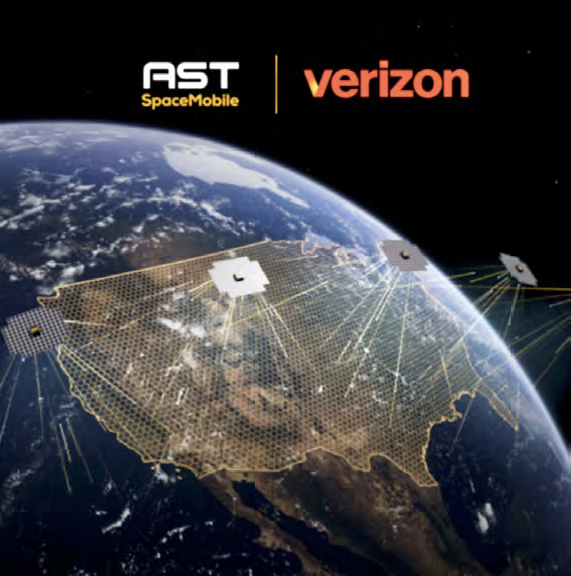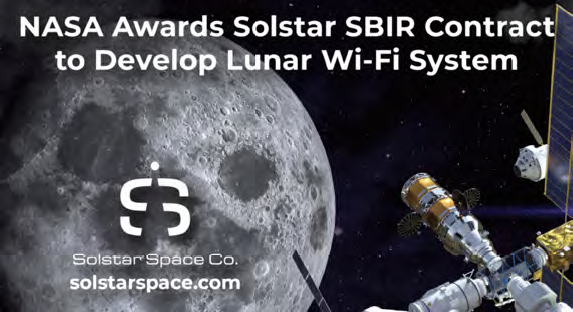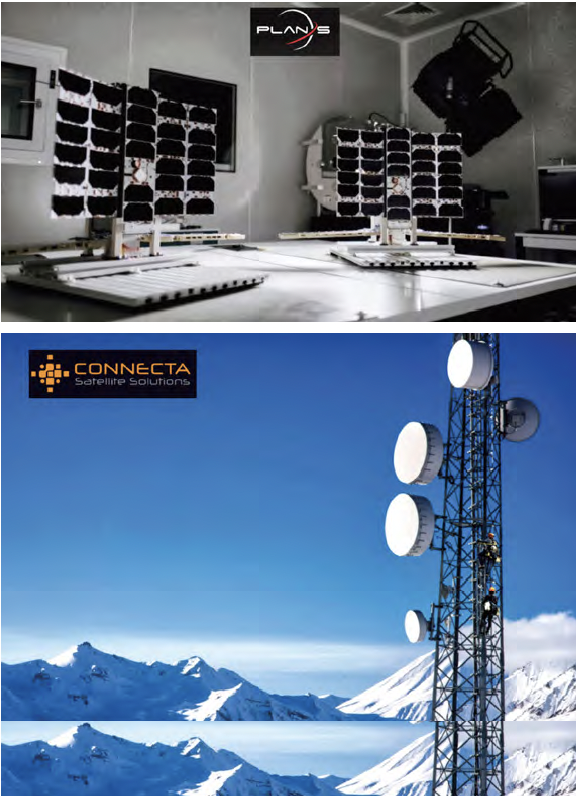AST SpaceMobile’s agreement with Verizon will enable customers Direct-to-Cellular access
AST SpaceMobile, Inc. (NASDAQ: ASTS) has signed a definitive commercial agreement with Verizon (NYSE, NASDAQ: VZ) to provide Direct-to-Cellular (D2C) AST SpaceMobile service when needed for Verizon customers starting in 2026—this service will further enhance Verizon’s already expansive and award-winning network, building upon the exceptional service and ubiquitous connectivity customers currently enjoy.

The combination of Verizon’s highly reliable terrestrial mobile network, the use of premium multi-operator 850 MHz cellular spectrum, and AST SpaceMobile’s next-generation, space-based cellular network in LEO is planned to enable cellular customers to stay connected wherever they are, from hiking trails to city centers and everywhere in between.
Featuring the largest-ever commercial communications arrays deployed in LEO, AST SpaceMobile’s network can connect directly to everyday smartphones, eliminating the need for specialized equipment.
AST SpaceMobile’s network is designed to operate across premium low-band spectrum, the company’s own licensed L-band and S-band spectrum, and up to 1,150 MHz of mobile network operator partners’ low- and mid-band spectrum, globally.
These aforementioned capabilities advance AST SpaceMobile’s efforts toward commercial service.
This agreement follows testing milestones that have proven the capabilities of the AST SpaceMobile network. In a recent demonstration, the companies successfully completed direct voice and video calls, as well as two-way RCS messaging, between standard, unmodified smartphones and a BlueBird satellite in space.
A crystal-clear Voice over LTE (VoLTE) call was made from a smartphone on Verizon’s network in Texas, connecting via an AST SpaceMobile satellite to another Verizon smartphone in New Jersey. These successful tests represent a significant leap in satellite-to-cellular technology and pave the way for a future of ubiquitous connectivity.
NASA awards Solstar Space SBIR contract to develop lunar Wi-Fi system
Solstar Space (Solstar) was recently awarded a NASA Phase I Small Business Innovation Research (SBIR) contract valued at $150,000 to develop a next-generation, Lunar Wi-Fi Access Point (LWIFI-AP) to support the agency’s Artemis program and Commercial Lunar Payload Services (CLPS) initiatives.

NASA has identified critical communication infrastructure requirements to support its upcoming missions as momentum builds around lunar exploration. One crucial aspect of the Artemis and CLPS programs includes deployment of SWaP-efficient (Size, Weight, and Power) Wi-Fi and 3GPP communications hardware across a range of lunar assets. This will include landers, rovers, and habitats as well as cislunar (moon orbit) spacecraft and assets like the Lunar Gateway.
Solstar’s proposed LWIFI-AP is designed to meet NASA’s demand for a space-rated, multi-mode, multi-protocol, and multi-band wireless access points capable of operating in extreme lunar conditions. This system will enable robust communications between astronauts, robotic systems, lunar vehicles, lunar surface-based and cislunar orbital assets. Solstar’s LWIFI-AP will be engineered to support real-time mission data flow, navigation, and scientific collaboration.
NASA’s technical requirements include the use of Wi-Fi across mission systems and subsystems within Artemis, such as the Human Landing System (HLS), CLPS payloads, Lunar Terrain Vehicle (LTV) services, and the Lunar Gateway’s Habitation and Logistics Outpost (HALO) and airlock module. Today, a commercial solution meeting these requirements is unavailable.
The NASA SBIR contract with Solstar will support development of a commercial product which meets the space qualification and environmental hardening needed for these mission-critical operations.
Solstar’s solution will address these challenges by providing hardware engineered for radiation tolerance, thermal survivability and low-SWaP constraints.
The space qualified Solstar LWIFI-AP will fill a key technology gap for NASA and its network of Artemis and CLPS contractors. The work performed under this Phase I contract will lay the foundation for a future flight-ready system capable of being hosted on a wide range of lunar mission platforms.
Founder and CEO, Solstar Space Company, Brian Barnett said, “Just like Wi-Fi revolutionized life on Earth, it will be essential for living and working on the Moon. Solstar’s mission has always been to keep people and systems connected in space, and this award moves us one step closer to enabling that vision for lunar missions. We are excited to contribute to NASA’s Artemis and CLPS programs by developing the communications infrastructure that future lunar operations will depend on. “Receiving this SBIR award is a milestone for Solstar and for space-based connectivity. As NASA prepares for a sustained human presence on the Moon, commercial innovation will be essential. With the Solstar LWIFI-AP, we aim to bring commercial-grade connectivity to the Moon, enabling seamless communication between crew, equipment, and mission control. We are proud to lead the way in developing the Wi-Fi backbone for the lunar economy.”
Türkiye grants 1st authorization for LEO satellite IoT services
Plan-S, the manufacturer and operator of Türkiye’s first LEO satellite constellation, has been authorized—through its subsidiary Connecta—by the Information and Communication Technologies Authority (BTK) to provide satellite-based Internet of Things (IoT) communication services in Türkiye.

These services will be delivered through the Connecta IoT Network, which is designed and manufactured in-house, with more than 90% of its sub-systems developed internally. These developments mark the first time a LEO satellite operator has been authorized in the country, underscoring both Plan-S’s leadership and Türkiye’s growing role in global space communications.
Plan-S oversees every stage of its satellite development in-house, from design and production to testing and integration, and has launched 17 satellites since the company’s founding in 2021. Its Connecta IoT Network, currently operating 12 satellites, will expand to 200 in the coming years. With the growing constellation, Plan-S will provide global coverage along with enhanced service capacity and quality.
This authorization paves the way for IoT services across industries such as agriculture, energy, logistics, mining, water management, and disaster responses, particularly in regions where terrestrial networks are limited or unavailable. Leveraging LoRaWAN-based technology for low-power connectivity, the Connecta IoT Network ensures scalable, energy efficient, cost effective, interoperable, secure and reliable data transmission for both fixed and mobile applications.
The company has incorporated 3GPP standard-based NB-IoT technology into its roadmap to enable seamless coverage for networks built on 3GPP standards, with the first satellites supporting this technology scheduled for launch next year. This positions the company as the first satellite operator to deliver IoT services based on both NB-IoT and LoRaWAN, two of the most widely adopted technologies for IoT services in the terrestrial domain.
The company has already advanced its global market strategy with authorization in Australia. This new authorization from Türkiye now acts as a catalyst for further global expansion, reinforcing the Plan-S’s position as a strategic player in satellite-based IoT communications.
In addition to IoT, Plan-S is developing its Observa constellation to deliver high-resolution Earth Observation and advanced data analytics. By 2030, the company aims to operate more than 200 satellites, building a comprehensive and independent space infrastructure to serve industries worldwide.
Novaspace projects $665 billion in satellite build and launch activity
Novaspace’s 28th edition of Satellites to Be Built and Launched reveals a decade of record-breaking orbital growth—more than 43,000 satellites are expected to launch by 2035, averaging 12 satellites and 8 tons of payload every day.This surge is set to drive a $665 billion market in manufacturing and launch services, fueled by mega-constellations, defense demand, and rapid innovation in launch technology.

“We’re seeing a rapid expansion in satellite activity and a shift in how space is used,” said Gabriel Deville, Manager at Novaspace. “Satellites are no longer just custom-built assets, they’re evolving into interconnected nodes within decentralized networks. This marks a new chapter in orbital complexity and global connectivity.”
Five mega-constellations will account for 66% of satellites launched between 2025 and 2034 yet contribute just 11% of total market value. The rise of such NGSO systems and the shift away from legacy GEO models has largely been fueled by Starlink’s demonstration of scalability and flexibility. Budget priorities, meanwhile, sits with defense. Defense remains the market’s economic anchor, capturing 48% of total value despite representing just 9% of satellite volume.
Looking to the launch market, the space transportation sector remains under bottleneck, with SpaceX enjoying a near-monopoly over heavy launch in the West. As several providers strive to introduce or ramp-up competing vehicles, Starship promises to profoundly redefine space transportation and the space economy at large.
Overall, the manufacturing and launch market offers significant revenue potential, however, targeting this opportunity will require a nuanced approach. Only 7% of the manufacturing market in value is fully open to any manufacturer and 70% is considered “nationally captive,” with the remainder locked by vertical integration of constellations. To compete here, consideration of strategic partnerships through the supply chain is now a must.
The 28th edition of Satellites to Be Built and Launched offers a 10-year market forecast along with a 20-year strategic outlook, covering demand, supply, technologies, and trends across the satellite and launch ecosystem. It includes a complete database of all satellites launched and planned, based on Novaspace’s proprietary forecasts.
The Classic edition provides an in-depth analysis of satellite applications and missions, satellite operators and users, technology trends in PDF format. It includes excel databases, covering all satellites, launched in the last decade, as well as satellites currently under construction, and launch forecast for the next decade as well as detailed status and maturity assessments of 550 commercial constellations of five satellites or more and discusses of business cases of the four mega-constellations.
The Premium edition adds access to quarterly update of the satellites launches and manufacturing contracts as well as an extended database of all government and commercial satellites launched and to be launched (10-year backlog and forecast), featuring 30 columns with detailed breakdown: constellation, specific application, manufacturing and launch contract status, information about satellite operator, manufacturer and launch provider.


